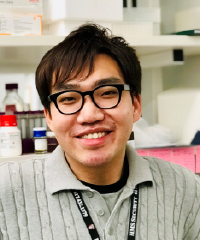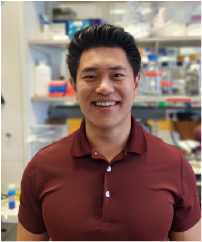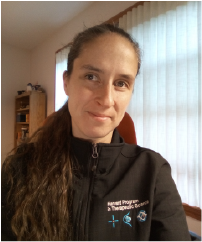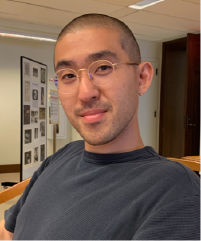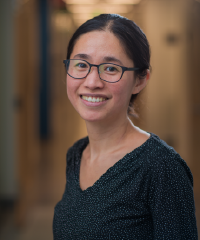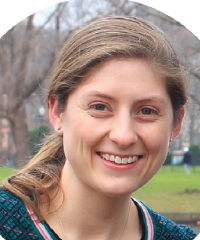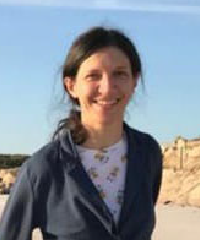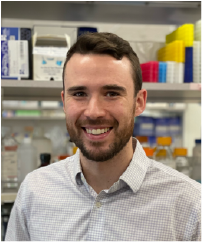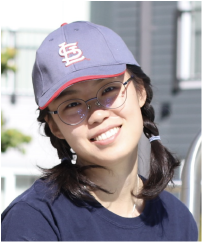Na Ryum (Danny) Bin, Ph.D.
Liberles Lab
Respiratory infections such as pneumonia and bronchitis caused by influenza viral infections, and more recently, COVID-19, are ranked among the leading causes of hospitalizations worldwide, presenting enormous social and economic burdens. Pathogen invasion causes immune cells to release a storm of inflammatory cytokines, many of which can be detected by sensory neurons. Nonetheless, questions remain unanswered on how neurons sense the presence of pathogens, and how responsive neural circuits orchestrate sickness behavior. In a recently published paper, I found rare petrosal sensory neurons that are engaged during flu-induced sickness behavior through prostaglandin E2 detection. My research in the Liberles lab focuses on delineating neural mechanism of sickness behavior caused by various naturalistic pathogens.
Kevin Dong
Gygi Lab
In the realm of cellular life, proteins reign supreme, carrying out countless vital functions. The ubiquitin-proteasome system (UPS) orchestrates targeted protein degradation through a cascade of interconnected proteins. Dysregulation of the UPS leads to human diseases. I seek to not only understand the intricate workings of the UPS but also harness its therapeutic potential by modulating or even hijacking its functions. In the Gygi Lab, we've developed cysDig, a targeted proteomic drug discovery platform that enables us to rapidly screen large electrophilic fragment libraries for binders against UPS cysteines. Using cysDig, we've discovered molecules that inactivate UPS proteins. Further optimization of these molecules can lead to first-in-class probes and potentially therapeutics for a wide range of human diseases. Through proteomics and a lot of TMT reagents, we chart a path to reshape covalent drug discovery and foster a healthier future.
Nomeda Girnius, Ph.D.
Brugge Lab
My research interest lies in understanding how the spatial distribution of cells in a tissue affects their behavior. To this end, I am applying multiplex imaging to tissues derived from an inducible mouse model to study the spatiotemporal distribution of oxidative stress and the cellular adaptations acquired by breast epithelial cells to survive it. My project aims to elucidate when and where cells experience stress over the course of tumorigenesis, and how cellular adaptations relate to the phase of carcinogenesis. My goal is to continue these types of studies, expanding to other mouse models of cancer to understand how different cancer drivers, as well as environmental factors like diet and smoke exposure, might influence oxidative stress and adaptation.
Marito Hayashi, Ph.D.
Liberles Lab
Signals emanating from the gut coordinate control over complex physiology and behavior such as food consumption, metabolism, and gastrointestinal (GI) physiology. Enteroendocrine cells (EECs) are the primary sensory cells of the gut-brain axis found in the GI epithelium. The diversity of receptors, secreted hormones, and downstream neuronal pathways of EECs suggests that the functional diversity of the gut-brain axis may be encoded and distributed among specific EEC subtypes or downstream pathways. However, the sensory properties of many of EEC subtypes and their connections to the nervous system remain elusive. The central goal of my research is to determine the sensory mechanisms and functional organization of the gut-brain axis, focusing on EECs of the gastrointestinal tract.
Felix Kraus, Ph.D.
Harper Lab
My research focuses on the impact of lysosomal dysfunction on organelle homeostasis. In particular, lysosomal storage diseases (LSDs) are comprised of ~50 mutants causing the accumulation of cellular material in the lysosome, accompanied by the loss of lysosomal function. Most LSDs have neuropathological presentations and have been associated as elevating risk factors for other neurodegenerative diseases, like Parkinson's disease (PD). Together with collaborators in the US and Europe, we have developed a quantitative proteomic and lipidomic framework to investigate and fingerprint LSD mutants both on the whole cell level and from isolated lysosomes. In combination with cell-biological and imaging approaches, this allows us to illuminate the molecular mechanisms and key players causing organelle disfunction in LSD mutants.
Chan Lee, Ph.D.
Harper Lab
The lysosome is a membrane-bound organelle in eukaryotic cells that has the unique capacity to degrade a broad range of macromolecules, including complex carbohydrates, proteins, and lipids. As such, lysosomes play crucial roles in various aspects of cellular physiology, such as maintaining proteostasis through mediating turnover of misfolded proteins or damaged organelles. Furthermore, the severe symptoms displayed by patients with lysosomal storage disorders clearly demonstrate the importance of proper lysosome function in human physiology. Therefore, my research is focused on unraveling the mechanisms involved in maintaining functional lysosomes. Using a combination of approaches, including quantitative proteomics and high-resolution microscopy, we have identified candidate proteins that may be involved in promoting lysosome function. We are now performing experiments to better understand how these proteins may be to regulating lysosomes.
Carman Li, Ph.D.
Brugge Lab
Cellular plasticity — the ability of cells to transition between different phenotypic states — plays a role in normal development and is often co-opted by cancer cells during malignant transformation. My research in Dr. Joan Brugge’s lab focuses on understanding how cell state plasticity contribute to the formation of breast cancer, a leading cause of mortality and morbidity. By generating mammary tumor models in genetically engineered mice and organoid cultures, and by applying high-resolution cell-profiling techniques, I have found that certain populations of normal mammary cells exhibit tumor-mimicking alterations in association with specific cancer risk factors, such as increasing age and inherited germline mutations in the tumor suppressor gene BRCA1. My goal is to delineate the molecular mechanisms underlying these cell state changes, which can inform better strategies for early detection and intervention of breast cancer.
Arda Mizrak, Ph.D.
Harper Lab
Cellular processes are driven by a constant flow of metabolic energy. However, variations in energy availability pose a major challenge for cells to maintain biological reactions. To overcome this challenge, cells have developed ways to store metabolic energy when energy is in excess and consume in times of need. Metabolic energy is stored in the form of fat in lipid droplets, which encapsulate neutral lipids with a monolayer membrane. Several metabolic enzymes involved in lipid homeostasis accumulate on lipid droplets, however, how proteins travel to a monolayer surface remains elusive. My research focuses on understanding the molecular mechanisms behind protein targeting to lipid droplets. By combining live cell imaging with single molecule tracking, we aim to understand how protein transport to a monolayer membrane is achieved.
Alex Panov
Harper Lab
The ubiquitin-proteasome system (UPS) is critical for maintaining basal proteostasis and addressing proteotoxic stress in cells. The central hub of this system is the proteasome, which turns over roughly 80% of all proteins in cells. The proteasome regulatory particle contains subunits that are modified with various post-translational modifications under different cellular conditions, some of which have been experimentally shown to affect protein turnover. My thesis work focuses on the role of uncharacterized proteasome post-translational modifications and how these modifications ultimately impact substrate turnover. Our lab is particularly focused on proteotoxic stress caused by unfolded proteins and protein aggregates, which broadly manifest in neurodegenerative diseases.
Valentina Rossio, Ph.D.
King Lab
Ubiquitylation regulates almost every cellular function and therefore deciphering enzyme-substrate relationships in the ubiquitin-proteasome system (UPS) is important in understanding how cells work. Deubiquitylating enzymes (DUBs) remove ubiquitin from proteins, thereby controlling their stability or activity. Because the UPS is dysregulated in many human diseases, DUBs are being explored as potential drug targets. The human genome encodes around 100 DUBs. While some DUBs are well-characterized, others have few known substrates. My research in the King lab aims to understand the mechanisms that govern the specificity of these enzymes. By using a proteomic approach, developed in collaboration with the Gygi lab, we have identified a wide range of DUB substrates that we are using to understand the principles governing DUB specificity.
Ji Seul Han, Ph.D.
Haigis Lab
Proper regulation of cellular metabolism is crucial for maintaining tissue and whole-body homeostasis. In response to high and low energy states, adipocytes play a critical role in energy storage and distribution. Furthermore, adipocytes actively engage in communication with neighboring cells, including various types of immune cell populations and cancer cells. The metabolic crosstalk between adipocytes and other cells has the potential to impact the microenvironment of tissues and the overall energy balance. However, our understanding of the role of adipose-derived metabolites in the context of obesity and tumors remains limited. In Haigis lab, my research objective is to gain insight into the mechanisms by which adipocytes and other cells communicate with each other, and how they collectively govern whole-body metabolism and tumor proliferation. Through this research, I strive to contribute to the expanding knowledge of the complex interplay between adipocytes and other cellular populations, shedding light on the role of adipose-derived metabolites in metabolic diseases and cancer.
Steven Shuken, Ph.D.
Gygi Lab
As a postdoctoral research fellow in the Gygi Laboratory, I am developing new mass spectrometry acquisition methods for proteomics with an emphasis on chemoproteomics and post-translational modifications. Specifically, I have developed the next generation of the GoDig acquisition software, which controls tribrid mass spectrometers and orchestrates the identification and quantification of hundreds of peptide targets in a single run. My improved “GoDig 2.0” software has sufficiently high success rates and reproducibility to reliably quantify single-peptide phenomena such as covalent drug-protein binding events and residue phosphorylation. I am currently developing new methods that will allow users to target peptides that are absent from the preexisting spectral/elution libraries currently used in GoDig. These methods will enable reliable, sensitive quantification of targets of interest with unprecedented ease and simplicity.
Michal Skowyra, Ph.D.
Rapoport Lab
Peroxisomes are membrane-bounded organelles that play vital roles in lipid metabolism and redox homeostasis in essentially all eukaryotic cells. Metabolic enzymes are imported into peroxisomes from the cytosol by a mysterious mechanism, which can transport folded proteins and even protein complexes using mobile receptors. My work reveals that the receptors shuttle cargo completely across the peroxisomal membrane and then return to the cytosol through a retrotranslocation channel. The receptors enter peroxisomes through a conduit filled by a selective phase. This phase resembles that formed by nucleoporin FG repeats inside nuclear pores and can be reconstituted as a hydrogel. These findings explain how folded proteins are imported into peroxisomes and define a previously unknown mechanism of protein translocation across membranes.
Conghui Yao, Ph.D.
Haigis Lab
As a key player in anti-tumor immunity, CD8+ T cells recognize tumor-associated antigens and induce apoptosis in targeted cancer cell. Upon activation, naive CD8+ T cells undergo rapid cell division and differentiate into effector T cells in the draining lymph node. These activated T cells traffic to the metabolically challenging tumor microenvironment where they proliferate, release cytokines and exert killing functions. In Dr. Marcia Haigis lab, I study the metabolic competition between intratumoral CD8+ T cells and tumor and how that restricts anti-tumor effects by using cutting-edge liquid chromatography coupled mass spectrometry.
Juntao Yu
Moazed Lab
Numerous studies in the past forty years have demonstrated the random distribution of parental histones to the two daughter strands during DNA replication. However, the mechanism governing the inheritance of parental histones remains unclear. My Ph.D. thesis in the Moazed Lab is to uncover the mechanism underlying parental histone inheritance and understand its contribution to epigenetic inheritance. Through genetics, biochemistry, and structural predictions, we determined the replisome components required for epigenetic inheritance. Furthermore, we identified a novel histone binding factor that contributes to the symmetrical inheritance of parental histones. These findings allowed us to propose a model on how the parental histone moves along the replisome for its inheritance. Moving forward, I am interested in extending my investigation on parental histone inheritance to understand its dynamics and explore its broader contribution to cell fate decision.
